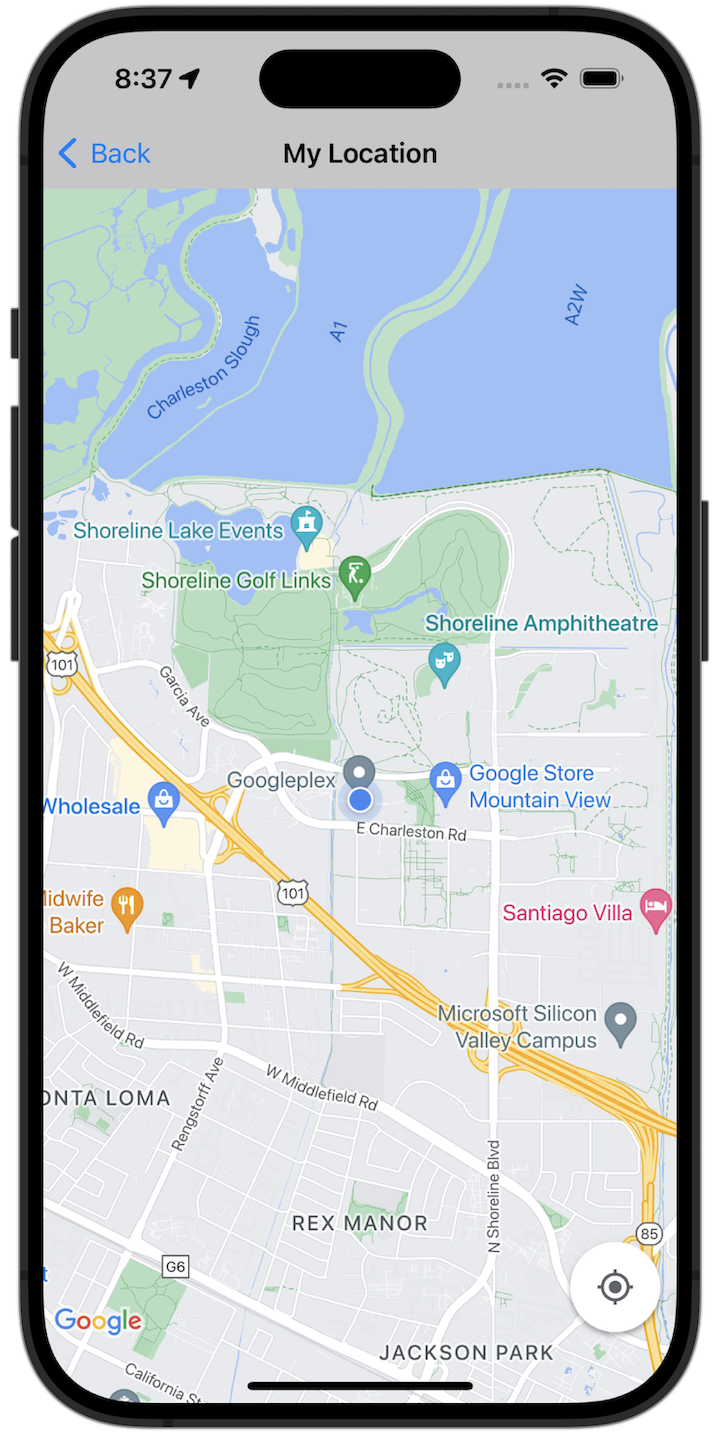
Primeiros passos
Antes de testar o exemplo de código, é necessário configurar o ambiente de desenvolvimento. Para mais informações, consulte Exemplos de código do SDK do Maps para iOS.
Ver o código
Swift
import GoogleMaps import UIKit class MyLocationViewController: UIViewController { private let cameraLatitude: CLLocationDegrees = -33.868 private let cameraLongitude: CLLocationDegrees = 151.2086 private let cameraZoom: Float = 12 lazy var mapView: GMSMapView = { let camera = GMSCameraPosition( latitude: cameraLatitude, longitude: cameraLongitude, zoom: cameraZoom) return GMSMapView(frame: .zero, camera: camera) }() var observation: NSKeyValueObservation? var location: CLLocation? { didSet { guard oldValue == nil, let firstLocation = location else { return } mapView.camera = GMSCameraPosition(target: firstLocation.coordinate, zoom: 14) } } override func viewDidLoad() { super.viewDidLoad() mapView.delegate = self mapView.settings.compassButton = true mapView.settings.myLocationButton = true mapView.isMyLocationEnabled = true view = mapView // Listen to the myLocation property of GMSMapView. observation = mapView.observe(\.myLocation, options: [.new]) { [weak self] mapView, _ in self?.location = mapView.myLocation } } deinit { observation?.invalidate() } } extension MyLocationViewController: GMSMapViewDelegate { func mapView(_ mapView: GMSMapView, didTapMyLocation location: CLLocationCoordinate2D) { let alert = UIAlertController( title: "Location Tapped", message: "Current location: <\(location.latitude), \(location.longitude)>", preferredStyle: .alert) alert.addAction(UIAlertAction(title: "OK", style: .default)) present(alert, animated: true) } }
Objective-C
#import "GoogleMapsDemos/Samples/MyLocationViewController.h" #import <GoogleMaps/GoogleMaps.h> @implementation MyLocationViewController { GMSMapView *_mapView; BOOL _firstLocationUpdate; } - (void)viewDidLoad { [super viewDidLoad]; GMSCameraPosition *camera = [GMSCameraPosition cameraWithLatitude:-33.868 longitude:151.2086 zoom:12]; _mapView = [GMSMapView mapWithFrame:CGRectZero camera:camera]; _mapView.delegate = self; _mapView.settings.compassButton = YES; _mapView.settings.myLocationButton = YES; // Listen to the myLocation property of GMSMapView. [_mapView addObserver:self forKeyPath:@"myLocation" options:NSKeyValueObservingOptionNew context:NULL]; self.view = _mapView; // Ask for My Location data after the map has already been added to the UI. GMSMapView *mapView = _mapView; dispatch_async(dispatch_get_main_queue(), ^{ mapView.myLocationEnabled = YES; }); } - (void)mapView:(GMSMapView *)mapView didTapMyLocation:(CLLocationCoordinate2D)location { NSString *message = [NSString stringWithFormat:@"My Location Dot Tapped at: [lat: %f, lng: %f]", location.latitude, location.longitude]; UIAlertController *alertController = [UIAlertController alertControllerWithTitle:@"Location Tapped" message:message preferredStyle:UIAlertControllerStyleAlert]; UIAlertAction *okAction = [UIAlertAction actionWithTitle:@"OK" style:UIAlertActionStyleDefault handler:^(UIAlertAction *action){ }]; [alertController addAction:okAction]; [self presentViewController:alertController animated:YES completion:nil]; } - (void)dealloc { [_mapView removeObserver:self forKeyPath:@"myLocation" context:NULL]; } #pragma mark - KVO updates - (void)observeValueForKeyPath:(NSString *)keyPath ofObject:(id)object change:(NSDictionary *)change context:(void *)context { if (!_firstLocationUpdate) { // If the first location update has not yet been received, then jump to that location. _firstLocationUpdate = YES; CLLocation *location = [change objectForKey:NSKeyValueChangeNewKey]; _mapView.camera = [GMSCameraPosition cameraWithTarget:location.coordinate zoom:14]; } } @end
Executar o app de exemplo completo localmente
O app de exemplo do SDK do Maps para iOS está disponível como um arquivo de download no GitHub. Siga estas etapas para instalar e testar o app de exemplo do SDK do Maps para iOS.
- Execute
git clone https://github.com/googlemaps-samples/maps-sdk-for-ios-samples.gitpara clonar o repositório de amostras em um diretório local. Abra uma janela de terminal, navegue até o diretório em que você clonou os arquivos de amostra e acesse o diretório GoogleMaps:
Swift
cd maps-sdk-for-ios-samples/GoogleMaps-Swift
open GoogleMapsSwiftXCFrameworkDemos.xcodeprojObjective-C
cd maps-sdk-for-ios-samples-main/GoogleMaps
open GoogleMapsDemos.xcodeproj- No projeto do Xcode, acesse Arquivo > Adicionar dependências do pacote.
Digite
https://github.com/googlemaps/ios-maps-sdkcomo o URL, pressione Enter para extrair o pacote e clique em Adicionar pacote. - No Xcode, pressione o botão de compilação para
criar o app
com o esquema atual. O build produz um erro, pedindo que você insira sua chave de API
no arquivo
SDKConstants.swiftpara Swift ou no arquivoSDKDemoAPIKey.hpara Objective-C. - Gere uma chave de API no seu projeto com o SDK do Maps para iOS ativado.
- Edite o arquivo
SDKConstants.swiftpara Swift ou o arquivoSDKDemoAPIKey.hpara Objective-C e cole sua chave de API na definição da constanteapiKeyoukAPIKey. Exemplo:Swift
static let apiKey = "YOUR_API_KEY"Objective-C
static NSString *const kAPIKey = @"YOUR_API_KEY";
- No arquivo
SDKConstants.swift(Swift) ouSDKDemoAPIKey.h(Objective-C), remova a seguinte linha, porque ela é usada para registrar o problema definido pelo usuário:Swift
#error (Register for API Key and insert here. Then delete this line.)
Objective-C
#error Register for API Key and insert here.
- Compile e execute o projeto. A janela do simulador do iOS aparece, mostrando uma lista de demonstrações do SDK do Maps.
- Escolha uma das opções mostradas para testar um recurso do SDK do Maps para iOS.
- Se for preciso permitir que o GoogleMapsDemos acesse seu local, escolha Permitir.

